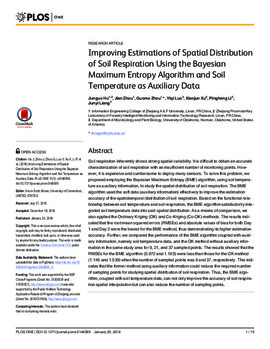| dc.contributor.author | Junguo Hu | |
| dc.contributor.author | Jian Zhou | |
| dc.contributor.author | Guomo Zhou | |
| dc.contributor.author | Yiqi Luo | |
| dc.contributor.author | Xiaojun Xu | |
| dc.contributor.author | Pingheng Li | |
| dc.contributor.author | Junyi Liang | |
| dc.date.accessioned | 2017-03-04T01:59:52Z | |
| dc.date.available | 2017-03-04T01:59:52Z | |
| dc.date.issued | 2016-01-25 | |
| dc.identifier.citation | Hu J, Zhou J, Zhou G, Luo Y, Xu X, Li P, et al. (2016) Improving Estimations of Spatial Distribution of Soil Respiration Using the Bayesian Maximum Entropy Algorithm and Soil Temperature as Auxiliary Data. PLoS ONE 11(1): e0146589. doi:10.1371/journal.pone.0146589 | en_US |
| dc.identifier.uri | https://hdl.handle.net/11244/49233 | |
| dc.description | This study was supported by the NSF China Programs (Grant No. 31300539 and 31570629) and the Public Welfare Technology Application Research Program of Zhejiang province (Grant No. 2015C31004). | en_US |
| dc.description | | en_US |
| dc.description.abstract | Soil respiration inherently shows strong spatial variability. It is difficult to obtain an accurate characterization of soil respiration with an insufficient number of monitoring points. However, it is expensive and cumbersome to deploy many sensors. To solve this problem, we proposed employing the Bayesian Maximum Entropy (BME) algorithm, using soil temperature as auxiliary information, to study the spatial distribution of soil respiration. The BME algorithm used the soft data (auxiliary information) effectively to improve the estimation accuracy of the spatiotemporal distribution of soil respiration. Based on the functional relationship between soil temperature and soil respiration, the BME algorithm satisfactorily integrated soil temperature data into said spatial distribution. As a means of comparison, we also applied the Ordinary Kriging (OK) and Co-Kriging (Co-OK) methods. The results indicated that the root mean squared errors (RMSEs) and absolute values of bias for both Day 1 and Day 2 were the lowest for the BME method, thus demonstrating its higher estimation accuracy. Further, we compared the performance of the BME algorithm coupled with auxiliary information, namely soil temperature data, and the OK method without auxiliary information in the same study area for 9, 21, and 37 sampled points. The results showed that the RMSEs for the BME algorithm (0.972 and 1.193) were less than those for the OK method (1.146 and 1.539) when the number of sampled points was 9 and 37, respectively. This indicates that the former method using auxiliary information could reduce the required number of sampling points for studying spatial distribution of soil respiration. Thus, the BME algorithm, coupled with soil temperature data, can not only improve the accuracy of soil respiration spatial interpolation but can also reduce the number of sampling points. | en_US |
| dc.language.iso | en_US | en_US |
| dc.publisher | PLos One | |
| dc.relation.ispartofseries | PLoS ONE 11(1): e0146589 | |
| dc.relation.uri | http://www.plosone.org/article/info%3Adoi%2F10.1371%2Fjournal.pone.0146589 | |
| dc.rights | Attribution 3.0 United States | |
| dc.rights.uri | https://creativecommons.org/licenses/by/3.0/us/ | |
| dc.subject | Soil respiration,Interpolation,Carbon dioxide,Entropy,Algorithms,Geostatistics,Probability distribution,Information theory | en_US |
| dc.title | Improving Estimations of Spatial Distribution of Soil Respiration Using the Bayesian Maximum Entropy Algorithm and Soil Temperature as Auxiliary Data | en_US |
| dc.type | Research Article | en_US |
| dc.description.peerreview | Yes | en_US |
| dc.description.peerreviewnotes | http://www.plosone.org/static/editorial#peer | en_US |
| dc.identifier.doi | 10.1371/journal.pone.0146589 | en_US |
| dc.rights.requestable | false | en_US |

